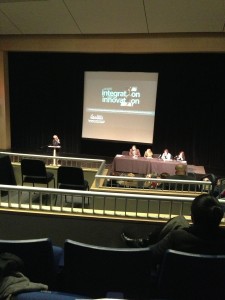Correlation is NOT the same as Causation
People often mistakenly believe that students who go to schools that are higher scoring must have gained more education at that school. In reality this confusion leads readers to think that attending high performing schools is the cause for higher achievement. For these reasons, people misunderstand claims made about Hartford student achievement in choice programs. In my opinion much of this confusion is due to the fact that many writers attribute success of students in choice programs to what school they attend. It is possible, however, that some students who applied to the program were already high achieving. Many articles that address the achievement gap between choice programs and district schools do not give evidence as to how or why choice programs are outperforming district schools, they simply say that integrated schools are the better schools. A major theme that I found while reading articles that express the issue of the achievement gap reflect correlation as being causation. In other words, these articles are implying that students’ high achievement in school is caused by which school they attend.
The article headlined, “State report: Students in desegregated schools test higher” by Jacqueline Rabe Thomas may imply to readers that there is a cause and effect relationship between desegregated schools and higher test scores. The headline of the article is technically correct because it is a fact, however, the problem is that readers may interpret the correlational statement to mean a causal one that “desegregated schools cause higher test scores”. This connection has yet to be proven because sufficient data has not been collected and examined such as records and comparisons of all students who have applied to and been accepted/denied to Choice Programs over the years. Later in her article Thomas quoted Martha Stone, “the lawyer behind the successful school desegregation lawsuit [in Connecticut]…” (Thomas, 1). Stone said, “The performance of Hartford youth soars once they attend magnet schools and schools in the suburb” (Thomas, 1). Stone jumps to the conclusion that attending magnet schools and schools in the suburbs causes the performance of Hartford youth to soar, leading readers to misunderstand the achievement of students within choice programs. Thomas later goes on to say, “When city students attend schools that enroll a mix of suburban and Hartford students, city students test higher” (Thomas, 3). This again is a fact, but the wording of the claim confuses readers and makes them think that the school they attend causes the success of the student.
A Research Analyst who commented on Thomas’ article clearly understood the correlation vs. causation conflict and stated it well that:
“The lawyer, Martha Stone would like everyone to believe that it is the desegregation that is causing the higher test scores… it is important for lay people not familiar with statistics to know that Correlation is NOT the same as Causation. In other words, just because it appears that 2 things are connected, it does NOT mean that one of those things caused the other” (Comment page in first article titled: “Correlation is not the same a Causation).
This comment helps readers understand how confusion arises out of the way people interpret the claims made about achievement in choice programs. Much of Thomas’ article states cause and effect; attending choice programs causes better test scores and academic achievement. In order to clear up this confusion, readers must understand that it is unknown whether or not choice schools are, in fact, causing higher academic achievement. In order to know what is causing higher academic achievement, data must be collected linking higher achievement to choice programs.
An article entitled, “Can Interdistrict Choice Boost Student Achievement” The Case of Connecticut’s Interdistrict Magnet School Program” written by Casey Cobb, Bob Bifulco, and Courtney Bell, explores whether or not student achievement is “boosted” by choice programs. Jack Dougherty, an Associate Professor at Trinity College, asked questions in a letter to Cobb, Bifulco, and Bell expressing his confusion and questions about how data was collected on Hartford students in comparison to non-Hartford students. In a letter responding to Jack Dougherty’s questions Bob Bifulco stated that the EEPA article which spoke about the high achievement of magnet school students, was based on assumption rather than fact because they “[could not] demonstrate [it] empirically” (Dougherty, 1). Correlation is not Causation, and because it is unproven that magnet schools indeed cause high achievement, causal language should not be used in articles that speak about student achievement in choice programs.
The image above is an example of the correlation/causation conflict. In the image it is implied that because one has an umbrella it will rain. The umbrella causes it to rain, which is not true, the umbrella and rain are simply correlated and the umbrella does not cause it to rain. Similarly, misunderstanding claims made about Hartford student achievement in choice programs is caused by the false connection between correlation and causation.
All too often people assume that because students attend higher achieving schools, the school causes the achievement. And not often enough do people think that students are high scoring and high achieving before they apply to choice programs. In my opinion, less causal language will equal less confusion among readers. There is information that can help people understand the correlation between Choice Programs and academic achievement. If all students who have applied to a Magnet lottery were tracked and compared over time (comparing those who were accepted to those who were not accepted) it would be more clear if the schools caused the achievement. Knowing what actually causes the achievement of students is very important to the public because it allows parents to make an educated decision for their children’s schooling, which ultimately effects their future. For these reasons, simply saying that a school causes academic achievement does not suffice when it comes to determining the “better school”. Without concrete proof that choice schools cause student achievement, writers should not use causal language that confuses readers.
I chose to edit this assignment because it was one that interested me a lot. The idea that Choice Programs cause academic achievement is a misconception that many people have. In the essay I gave more evidence to a lot of my points as well as sharpened some of my claims to be better understood by the reader. I agree that Magnet schools are great, however the assumption that these schools cause success undermines the intelligence of the students attending the schools. I gave more reasons why it is still unknown whether or not Choice Programs cause academic achievement as well as ways in which research can be done in order to tell if Choice Programs, in fact, cause higher academic achievement.
Work Cited:
Jack Dougherty, correspondence with Robert Bifulco re: their EEPA article.
Thomas, Jacqueline R. State report: Students in desegregated schools test higher.
2013. <http://www.ctmirror.org/source/jacqueline-rabe-thomas>.
Thomas, Jacqueline R. State report: Students in desegregated schools test higher.
2013. <http://www.ctmirror.org/source/jacqueline-rabe-thomas>. Comment: “Correlation is NOT the same as Causation”
http://www.thegraphicrecorder.com/2012/01/18/freakonomics-correlation-≠-causation-money-cant-buy-elections/ (for image).






